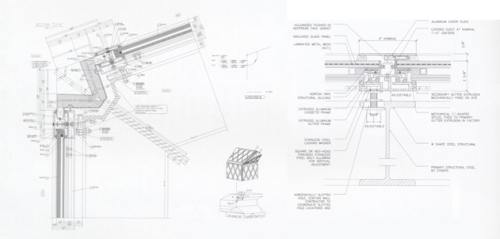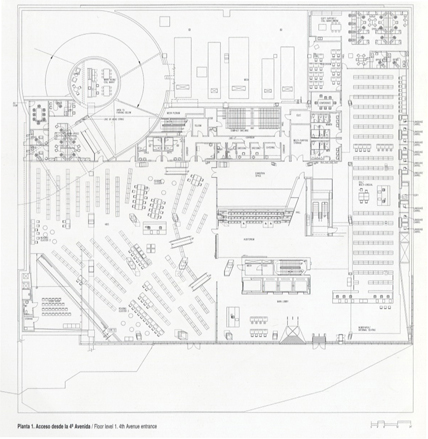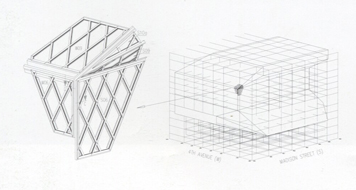Here the Seattle Central Library is represented by a cross section throughout the entire building. These documents are usually created to describe the vertical interactions between spaces, which combined with the plan drawings allows for a three dimensional perception and abstraction of the spaces. Considering the binary system of compartmentalized flexibility at play in this building, this technical drawing allows to better understand the vertical articulation and sequence of enclosed boxes and open spaces, but also the spaces connecting different horizontal planes, like the auditorium between the 1st and 3rd floor and the book spiral connecting the 6th and the 10th floor. Therefore, this document identifies the spatial interweaving between the different floors and rooms, and by doing so it traces the spatial ecologies at work in this building. Despite their different spatial identities, rooms of this library do not exist simply as discrete spaces, but are engaged in a process of mutual stimulation and visual interaction, and this cross section allows for a potential understanding of the compositional positioning of such spaces. Moreover, the cross section is not exhausted in the interior relations, but offers an insight of how this spatial ecology relates to the exterior world, specifically on the 1st and 3rd floors.
Posts Tagged 'technical drawing'
cross section
Published March 9, 2008 Uncategorized Leave a CommentTags: architect, auditorium, book spiral, construction, el croquis, interior, orthogonal, print, professional audience, section, technical drawing
façade section
Published March 8, 2008 Uncategorized Leave a CommentTags: construction, el croquis, engineer, exterior, orthogonal, print, professional audience, section, technical drawing
This representation is composed of four orthogonal view drawings, two and three dimensional, which combined enumerate different components of the façade in two distinct places, namely on the connection between two planes of the façade and on the connection to the structure. The smaller images situate the detailed sections on the building’s envelope, while the larger images describe them.
The larger images represent an imaginary section and detail the intricate joints of the façade. Two components can be seen in these sections, specifically the drawn and the written information. Having as basis an abstract image, the names, dimensions and drawing conventions convert it into a precise representation of a buildable component. Without these elements, this drawing would be limited to the exercise of aesthetics (on which it also performs on its own right)and be outstripped of its functional meaning. If you can’t name it and you can’t measure it, you definitely cannot (accurately) build it. Like the map and the territory, these sections are frequently scaled one to one (when not bigger). Simulation is devised before the real; in these drawings we observe a generation by models of a real, which has been mapped before its existence, and whose ultimate goal is a physical reality.
plan
Published March 7, 2008 Uncategorized Leave a CommentTags: architect, construction, el croquis, interior, orthogonal, plan, print, professional audience, technical drawing
This representation depicts the first floor of the library, and like all plans, it is drawn from an imaginary point in space. This conceptual view, also known as “top view,” is based on the premises of a section plan, parallel roughly three feet above the plane depicted in the drawing, in a constructed orthogonal view, upon which everything shown in the plan is projected. This sort of representation is in many ways similar to code, as it is comprised by a specific language understood by architects and other building professionals but not easily understood by people outside the field. Nonetheless, untrained eyes can still discern a general idea of some elements here depicted (a notion of space, for example). Discernment of other elements like materiality and structural integrity require another level of training. Like code, the language of such plans is highly reliant on conventions and serves as a fundamental element of the design and construction process, as fluency enables architects and builders to establish communication and illustrate ideas. However, instead of being decoded into software operations or instructions on a computer, this simple two dimensional drawing is immediately converted into a three dimensional space, firstly in the minds of all the people involved in the design and (later) in the construction process. It is interesting to note how this plan makes visible the subtle interplay between the main program (in this case/plan, the children’s section) and the “dirty realism” often forgotten or erased in similar representations with a different audience, like the multiple directional structural columns punctuating the actual space.
façade detail
Published March 3, 2008 Uncategorized Leave a CommentTags: 3-D, architect, construction, el croquis, exterior, print, professional audience, technical drawing
This technical drawing illustrates the point where several seams of the façade of the building come together. This particular document is composed of two distinct axonometric drawings at two distinct scales. This sort of document is usually developed by engineers to assist in the construction process, identifying and explaining specific situations where the overall system (in this case the façade) has to deal with a singular situation, such as this joint.
On the image illustrating the actual corner, we have a clarification of the method employed by the engineers to solve the façade’s intricate network geometry, favoring the network uniformity in each plane, even if it implied the introduction of large transitional pieces at the edges.
In the smaller scale drawing which serves to situate this specific façade detail on the overall envelope of the building, the Cartesian coordinate system is embodied by the structural grid, laid out by the engineering team. As each point of this building finds its place in space through the x, y and z coordinates, it seems to disregard the paradigm shift announced by the architectural digital avant-garde and the highly curvilinear nurb calculated surfaces that characterize it. The computing power at our disposal today was not employed in this building’s formalistic operation, but in the calculation of its structural integrity.



